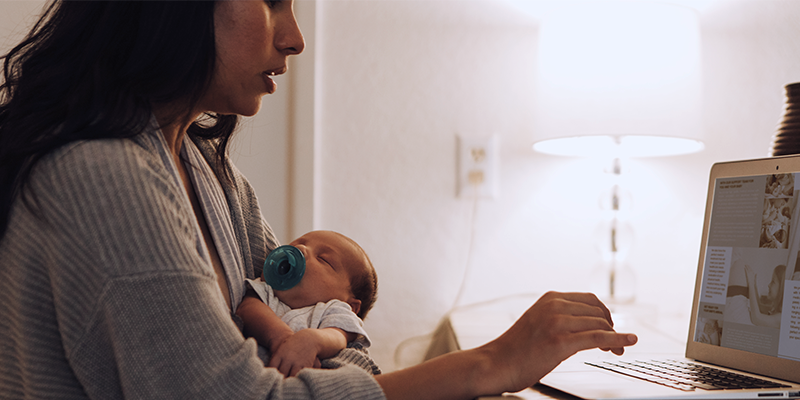Is It Real or Braxton Hicks? How to Tell If You’re In Labor
Come on, baby! As you hit the middle of your third trimester, it can take everything in you to practice patience for your little one’s arrival — we get it! Waiting isn’t our strong suit either. However, in all the excitement of getting ready for the little bundle, many mamas forget to ever talk to their doctor or midwife about what to expect with labor. It can be hard to understand when to call the hospital or when to grab all the belongings and hop in the car — especially with all of the Braxton Hicks stories. So here’s the scoop on whether it’s real labor or Braxton Hicks and how to know when it’s really time.
When to Call the Doctor
First and foremost, there are a few instances when you’ll absolutely want to call your doctor or healthcare professional. These symptoms can be warning signs of true complications, and waiting to call can only make it worse.
You experience headaches or vision changes. Are you experiencing an abnormal amount of headaches, or do you have any blurred vision? Both of these can be signs of hypertension or even preeclampsia, which both need to be taken very seriously. Your doctor can let you know if you need to be seen immediately or if you’re just in need of rest.
You have bright red bleeding. This one may be obvious, but if you’re experiencing bleeding and is appears bright red, it’s time to see your doctor.
Baby is quiet. Around this time, you should feel your little one moving about 10 times an hour. If baby has gone quiet or is moving noticeably less, give your doctor a ring. Active little ones are healthy little ones!
Signs You Might Experience
There are a few “non-technical” signs that you can experience that let you know baby is on the way! Keep an eye out for these and know that you might be meeting that little bundle very shortly.
Cramps and back pain. You may experience both of these throughout the last trimester of your pregnancy, but if they begin to worsen and intensify, it can be an indicator that you’re getting close and your body is preparing for the big event.
Diarrhea. We know, gross, but some report having bouts of diarrhea close to when their water broke. You will be experiencing a lot of muscle preparation and tension, which can cause abnormal bodily functions.
Discharge. You should always be keeping an eye on your discharge, as it can be a great indication of your sexual health and pregnancy. If you’re experiencing additional discharge, it can be that your water has broken on a smaller scale. If you’re seeing some blood, this can be a sign that your mucus plug has been removed. Give your healthcare provider a call with any differences.
Pelvic pressure. This one may seem obvious as well, but the lower your little one gets, the more you’ll feel pressure in your pelvic area. Strong pressure can mean things are about to happen.
For Sure Signs
There are more certain and obvious signs of labor. If you experience any of these, it’s definitely time to get ready to go, mama!
Indications at your appointments. In your last few prenatal appointments, did your doctor or midwife let you know that baby’s head was down, you were dilated and your cervix was softening? All of these are HUGE indicators of baby’s arrival and that labor is on its way.
Your water breaks. This one is possibly the most obvious, but doesn’t always happen the way they show in the movies. You may experience a large and noticeable gush, but it could also happen in the middle of the night and come as a sneaky surprise — just pay attention to your body.
Your mucus plug detaches. Some people call this the “bloody show.” When you notice bleeding out of nowhere, it’s likely time.
Consistent contractions. When you start experiencing contractions that consistently happen so-many minutes apart, get those bags packed and call a cab — baby’s coming!
Fake vs. Real Labor
So how can you tell if the above is truly labor? Maybe you’re feeling some contractions and cramps, but are worried it’s just Braxton Hicks. Below are a few ways to tell the difference between Braxton Hicks and true labor.
Consistency of contractions. With Braxton Hicks, you’ll find that contractions are hard to time out — they’ll seem irregular and with no rhyme or reason. However, with true labor you’ll be able to schedule out when your next contraction will hit — 20 minutes from now, 10 minutes from now, 5 minutes from now….you get the idea.
Contractions and movement. During a bout of Braxton Hicks, you’ll be able to move to a different position to find some comfort from the contractions. While you may experience contractions while standing, once you sit or lie down, they go away. However, with true labor, you’ll be stuck with those contractions no matter how you position yourself.
Intensity of contractions. Braxton Hicks, likely means you’ll be experiencing weak contractions that don’t get stronger or worse with time. However, when you’re going into labor, you will definitely feel the contractions get stronger and more noticeable.
Location of pain. In false labor, you may be experiencing pain in your abdomen, similar to menstrual cramps, and they probably won’t move around on you. However, when you go into real labor, you should experience back pain that eventually moves to the front.
So pack that hospital bag, finish all that nesting and do what you gotta do before baby arrives, and get ready to meet that little one, Mama, the baby is on its way!
Items of the Day
Trimester Gift Boxes
$49.99
Join the other 1,000,000+ expecting mamas who love Bump Boxes.





















